
Welcome to Aetna Springs Resort
I'm into history, and I'm into roadside curiosities, and I'm especially into historical roadside curiosities. So I had heard of Litto's Hubcap Ranch, where thousands of hubcaps were on display, in Pope Valley. But I knew the hubcap collector had died, and wasn't sure if it was still around, and neither did I know exactly where Pope Valley was, other than somewhere in the Northern California wine country. Then I read about a hike sponsored by the Napa County Land Trust that would afford people the opportunity to see an abandoned, historic hot springs resort in Pope Valley, and that was more than enough impetus to set me off in search of Pope Valley to see what there was to see.
The valley is awfully close to Napa, but not so easy to get to. It's about 30 miles from Napa (a scant 12 from St. Helena), but the scenic drive takes about an hour, winding through the hills with constant sharp turns on steep inclines.
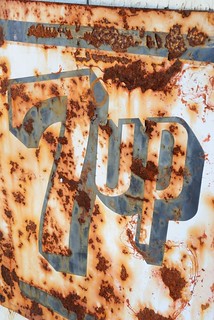
But once one arrives at the bottom of Howell Mountain Road and the junction with Pope Valley Road, the historical sites leap right out at the traveler. There to the left is the Pope Valley store, covered in old metal advertising signs and with a classic visible style gas pump--meaning there is a clear glass cylinder on top where the gasoline to be purchased could be seen and measured with markings on the side. On the right appears to be an even older piece of history, the Henry Haus Blacksmith Shop, nestled under a tree and straddling a small creek.
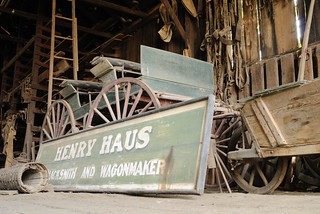
They were interesting enough just to look at from the outside, but thanks to the Napa Historical Society and Napa County Landmarks, I later got to see inside both of them. And they were chock full of goodies, lots of antiques, and junk.
Swiss immigrant Henry Haus, according to the literature of the historical societies, arrived in Pope Valley in 1889 at the age of 16 and provided blacksmith services to the valley from 1897-1950. Inside his shop lies all that was there when he closed it up in 1950, old metal tools, wagon wheels, and even cans of food.
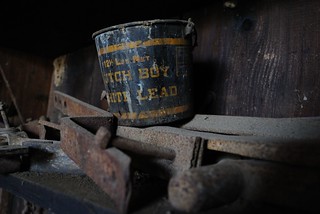
The interior of the Pope Valley Store is even more crowded with antiques, collectables, and just plain old junk. If it weren't for the historical nature of the property, it might be a candidate for the television show Hoarders. There are many precious antiques and interesting artifacts mixed in among the dozens of Jolt Cola cans, and everything is getting covered with a fine layer of mouse-poop dust. And the smell! Mouse urine, I was told. In high concentrations.
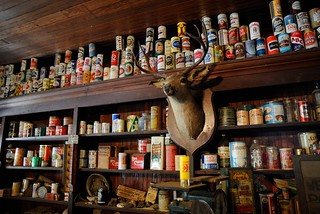
The store had many uses. The front part lined with bottles and cans appears to be the store portion. In the room behind that is an old bar with some great old refrigerator units in the wall. Climbing up a staircase outside on the back of the structure, one reaches the "hotel," a handful of rooms on the second floor. While there is some evidence from a few pieces of antique furniture that it was once well appointed, it now resembles a film noir flophouse. Tucked in a corner near the stairs is a an unexpected gem: a tiny telegraph room--with the remains of telephone exchange in the next room over. Compared to the first floor, this area is less crowded, and quite a bit less smelly--although the dead bat in the window near the landing is quite unpleasant enough.

Purchase this photograph.
Driving farther north up Pope Valley Road, one finds the Pope Valley Winery, established in 1897 as the Burgundy Winery by Swiss blacksmith Ed Haus, brother to Henry of the aforementioned blacksmith shop. According to the winery's literature, they produced wine that was shipped to Al Capone during prohibition.

It's a pleasant stop with picnic tables, a bocce ball court, a friendly staff, and, best of all, my favorite kind of wine--free wine! Yes, tasting is free. The lovely bottle of port we took home was not, however.
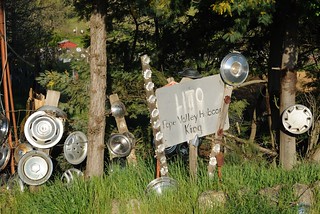
Just a smidgeon farther up the road is Litto's Hubcap Ranch, complete with historical marker. The story goes that Litto Damonte (1892-1985) put some of the stray hubcaps that flew off onto his property together along the road, and people started leaving more there. Now there are over 2,000 of them on display. Living in Pope Valley seems encourage the hoarding impulse . . . .
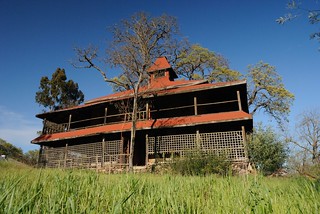
Finally, there is the highlight of Pope Valley, the largely decaying, but partially preserved, remains of a grand old hot springs resort, Aetna Springs. A resort was first opened there in 1873, but many of the most interesting buildings at the site were built, or remodeled, later and designed by Bernard Maybeck and Julia Morgan.
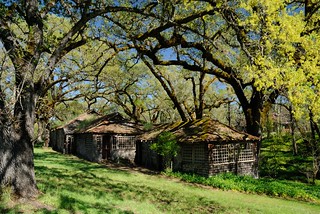
Buildings designed by Julia Morgan. Purchase this photograph.
Attracting Hollywood stars in addition to the just generally wealthy, the resort must have still had some cachet in 1966 when Ronald Reagan announced his intention to run for governor of California there. Yet the resort closed just 6 years later.
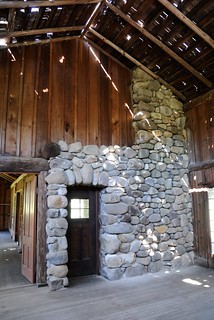
For some years after, the resort was used for retreats by the Moonies. The business that currently owns the property, apparently, is the one that was associated with the Reverend Sun Myung Moon’s Unification Church. They have leased the property to parties interested in redeveloping the resort, but without success. In 1999 a measure before the voters of Napa County that would have allowed redevelopment was voted down. A decade later, renovation had begun on some of the buildings, but the move by the county to reject a planned golf course adjacent to the resort led the developer--citing investor flight--to cease operations.
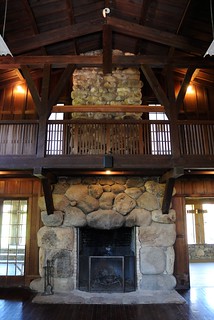
Maybeck Interior
But in 2012, things changed. The same developer that had ceased operations in 2009, presumably with new backers, received approval from the county planning commission to revive the resort. Doing so will involve restoring 28 buildings, according to a story in the Napa Valley Register.

But some of the beautifully decaying ruins that exist on the site now will have to be cleared, according to the architect who guided us on Pope Valley Day. They are too far gone to be restored, and there is no way in our litigious society to preserve them just to look at as they slowly sink back into the earth. Some idiot might try to go inside and end up killing himself. Luckily, I got some photos.
No comments:
Post a Comment